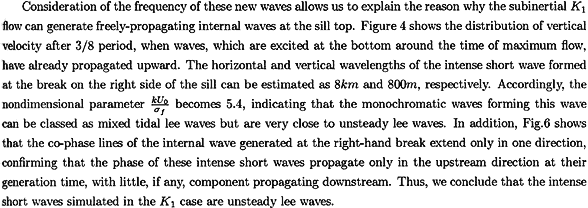We call these three types of waves “topographic iternal waves” whose properties are as follows. Unsteady lee waves include classical steady lee waves in the limit of kU0/σf→∞. Their frequencies are -kU(t), and their phase velocities are -U(t). Thus, unsteady lee waves can propagate in the upstream sense as it exists at the time of their excitation (upstream-ward at their excitation time), relative not only to the fluid but also to the ground as the flow varies in time and/or space. The amplitudes of unsteady lee waves depend on the magnitude of the forcing at the time of their excitation, so that the waves generated around the time of maximum flow have maximum amplitudes. Such unsteady lee waves are excited in a region where the curvature of topography is sufficiently large, such as shelf breaks. In contrast, internal tides have a frequency of ±σf and a phase velocity of ±σf/k, which are constant, and propagate in both directions, as shown in previous studies. In the intermediate range, excited waves have intermediate properties between those of lee waves and internal tides, and we name such waves “mixed tidal lee waves”.

3.4 Evolution of large-amplitude unsteady lee waves
Figures 5 and 6 show the potential density (σθ) and vertical velocity(w) in the K1 case, respectively, up to 1 period, when the generation process of the intense short waves can be seen clearly.
As expected from our theoretical model, small-scale vertical-velocity distributions produced at sudden changes in the sill slope generate a relatively large depression of small horizontal length at the right-hand break and adjacent weak elevation and depression over the left-hand break and sill top. These features are for the intense short internal waves described earlier.
The displacement at the right-hand break continues to grow until the end of the rightward flow to form a large-amplitude (-100m) unsteady lee wave (Fig. 5d). Such wave growth in the decelerating stage is often observed both in the field and laboratory studies. It is noteworthy that, while the lower part of the wave stays at almost the same place, the upper part propagates upstream (leftward) and the wave leans toward the upstream side. The induced co-phase line of vertical velocity also tilts obliquely, indicating that modal waves have not yet been formed. Therefore, the modal wave approximation used in Hibiya (1986)'s model is not appropriate for understanding the amplification mechanism of this wave.
As the rightward flow vanishes after 0.5 period, the large-amplitude unsteady-lee wave begins to propagate upstream at the generation time (leftward) (e.g., Fig. 6). Such propagation processes of short internal waves generated on the downstream side of a sill are also captured by observations (e.g., Farmer and Smith 1980). As the upper part of this unsteady lee wave is reflected at the surface, there appears a 3rd-mode-like structure in the wave field over the sill top after 0.625period (Fig. 6e).